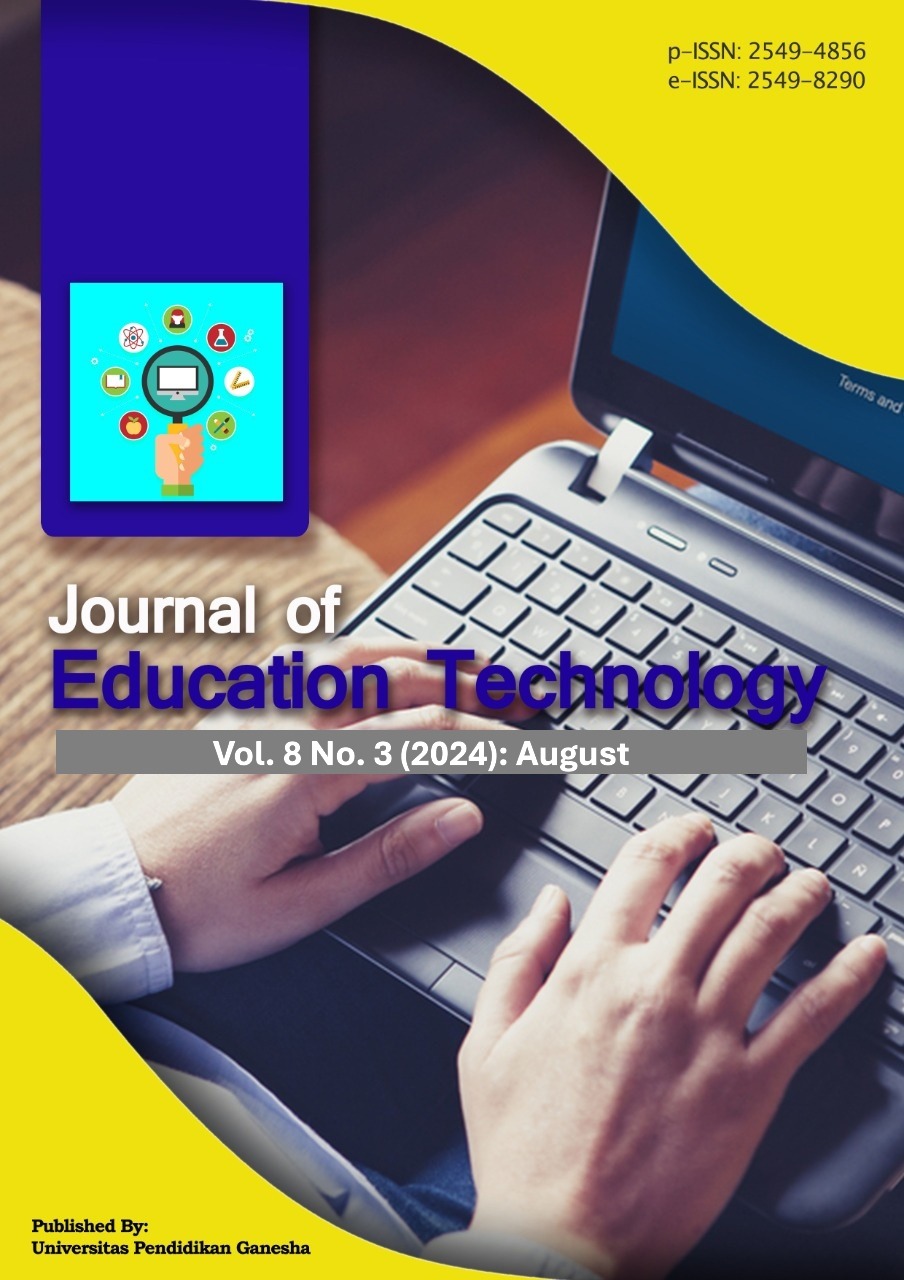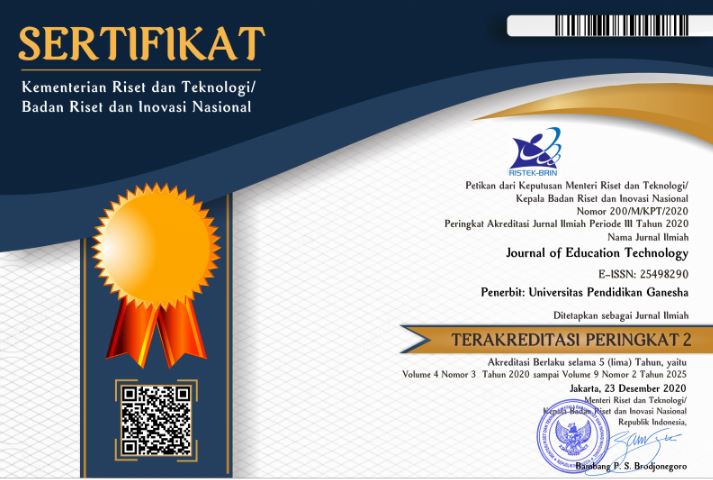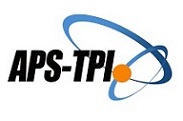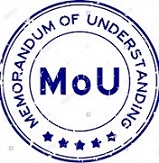Correlation of Blended Learning Aspects Based on Characteristic of Education and Training Participants based on the iPosyandu Midwife Application
DOI:
https://doi.org/10.23887/jet.v8i3.70783Keywords:
Blended Learning, Characteritics, iPosyandu ApplicationAbstract
Education and Training (Diklat) with blended learning is training with learning carried out face to face directly and indirectly (synchronous and asynchronous). Asynchronous learning can use the iPosyandu application as a learning medium in professional training. However, success in the asynchronous learning process using the iPosyandu midwife application is related to the characteristics of the training participants. This research aims to analyze aspects of blended learning based on the characteristics of education and training (training) participants based on the iPosyandu Midwife Application. This research method used quasi-experimental with posttest design. Data were collected in this research by giving questionnaires about aspects of blended learning to 95 midwives with analysis of bivariate data with the Spearman statistical test using STATA version 15 software. This study showed no relationship between aspects of blended learning (pedagogical design, social design, ethnic design, different options) and the characteristics of training participants (age, education, occupation, period). work, last training) with a value of r=0.00-0.20; p-value>0.005. Thus, the iPosyandu Midwife application as mobile learning (mLearning) can contribute to learning for trainees using the Blended Learning method. iPosyandu midwife application can be used by trainees with various ages, education levels, occupations, and tenure, as well as training experience.
References
Abroto, A., Maemonah, M., & Ayu, N. P. (2021). Pengaruh Metode Blended Learning dalam Meningkatkan Motivasi dan Hasil Belajar Siswa Sekolah Dasar. Edukatif: Jurnal Ilmu Pendidikan, 3(5), 1993–2000. https://www.edukatif.org/index.php/edukatif/article/view/703.
Adamsn, D., Tan, M., & Suminotono, B. (2021). Students’ readiness for blended learning in a leading Malaysian private higher education institution. Interactive Technology and Smart Education, 18(4), 515–534. https://doi.org/10.1108/ITSE-03-2020-0032.
Akhmadi, A., Diklat, B., & Surabaya, K. (2021). Implementation of Blended Learing in Training. Jurnal Diklat Keagamaan, 15(1). https://doi.org/10.52048/inovasi.v15i1.214.
Alenezi, A. (2020). The role of e-learning materials in enhancing teaching and learning behaviors. International Journal of Information and Education Technology, 10(1), 48–56. https://doi.org/10.18178/ijiet.2020.10.1.1338.
Angiolini, C., Ducato, R., Giannopoulou, A., & Schneider, G. (2020). Remote teaching during the emergency and beyond: Four open privacy and data protection issues of ‘platformised’education. Opinio Juris in Comparatione, 1, 45–47. https://doi.org/http://www.opiniojurisincomparatione.org/opinio/article/view/163/171.
Araka, E., Maina, E., Gitonga, R., Oboko, R., & Kihoro, J. (2021). University students’ perception on the usefulness of learning management system features in promoting self-regulated learning in online learning. International Journal of Education and Development Using Information and Communication Technology (IJEDICT, 17(1), 45–64. http://erepository.uonbi.ac.ke/handle/.
Asih, N., & Ramdhani, S. (2019). Peningkatan Kemampuan Pemecahan Masalah Matematis dan Kemandirian Belajar Siswa Menggunakan Model Pembelajaran Means End Analysis. Mosharafa: Jurnal Pendidikan Matematika, 8(3), 435–446. https://doi.org/10.31980/mosharafa.v8i3.534.
Barton, M. A., Lall, M. D., Johnston, M. M., Lu, D. W., Nelson, L. S., Bilimoria, K. Y., & Reisdorff, E. J. (2022). Reliability and validity support for an abbreviated Copenhagen burnout inventory using exploratory and confirmatory factor analysis. Journal of the American College of Emergency Physicians Open, 3(4), 1–19. https://doi.org/10.1002/emp2.12797.
Bizami, N. A., Tasir, Z., & Kew, S. N. (2023). Innovative pedagogical principles and technological tools capabilities for immersive blended learning: a systematic literature review. Education and Information Technologies, 28(2), 1373–1425. https://doi.org/10.1007/s10639-022-11243-w.
Brinia, V., Katsionis, C., Gkouma, A., & Vrekousis, I. (2023). Attitudes and Perceptions of School Principals about the Contribution of Evaluation to the Efficient Operation of Schools Both at the Administrative and Educational Levels. Education Sciences, 13(4), 366. https://doi.org/10.3390/educsci13040366.
Burhendi, F. C. A., Abdurrozak, A., & Soenarto, S. (2020). The implementation of blended learning models based liveboard against affective aspects in modern physics course. Gravity : Jurnal Ilmiah Penelitian Dan Pembelajaran Fisika, 6(1). https://doi.org/10.30870/gravity.v6i1.7106.
Cassum, S., Mansoor, K., Hirji, A., David, A., & Aijaz, A. (2020). Challenges in Teaching Palliative Care Module Virtually during COVID-19 Era. Asia-Pacific Journal of Oncology Nursing, 7(4), 301–304. https://doi.org/10.4103/apjon.apjon_42_20.
Christianto, D. (2019). Efforts to support and expand the use of educational technology as a means of delivering learning. International Journal of Indonesian Education and Teaching, 3(1), 128–136. https://doi.org/10.24071/ijiet.v3i1.1725.
Cocquyt, C., Zhu, C., Diep, A. N., Greef, M., & Vanwing, T. (2019). Examining the role of learning support in blended learning for adults’ social inclusion and social capital. Computers and Education, 142. https://doi.org/10.1016/j.compedu.2019.103610.
Dridi, M. A., Radhakrishnan, D., Moser-Mercer, B., & Deboer, J. (2020). Challenges of Blended Learning in Refugee Camps: When Internet Connectivity Fails, Human Connection Succeeds. International Review of Research in Open and Distributed Learning, 21.
Gaitas, S., & Alves Martins, M. (2017). Teacher perceived difficulty in implementing differentiated instructional strategies in primary school. International Journal of Inclusive Education, 21(5), 544–556. https://doi.org/10.1080/13603116.2016.1223180.
Gopalakrishnan, L., Buback, L., Fernald, L., Walker, D., & Diamond-Smith, N. (2020). Using mHealth to improve health care delivery in India: A qualitative examination of the perspectives of community health workers and beneficiaries. PLoS ONE, 15(1). https://doi.org/10.1371/journal.pone.0227451.
Haerani, I. (2021). Predictor of Purnawidya Performance Post Training of Wound Care Blended Learning Method in DKI Jakarta. Jurnal Inovasi Aparatur, 3(2), 352–361. https://garuda.kemdikbud.go.id/documents/detail/2507787.
Hinneburg, J., Lühnen, J., Steckelberg, A., & Berger-Höger, B. (2020). A blended learning training programme for health information providers to enhance implementation of the Guideline Evidence-based Health Information: Development and qualitative pilot study. BMC Medical Education, 20(1). https://doi.org/10.1186/s12909-020-1966-3.
Huang, H., Hwang, G.-J., & Jong, M. S.-Y. (2022). Technological solutions for promoting employees’ knowledge levels and practical skills: An SVVR-based blended learning approach for professional training. Computers & Education, 189, 104593. https://doi.org/10.1016/j.compedu.2022.104593.
Ismarwati, I., Putri, I. M., Daryanti, M. S., & ... (2022). A Formation of Peer Counsellors in an Effort to Create a Youth Information and Counselling Center at SMP Muhammadiyah Banguntapan, Bantul Yogyakarta. ABDIMAS: Jurnal Pengabdian Masyarakat, 5(1). https://journal.umtas.ac.id/index.php/ABDIMAS/article/view/2141.
Joos, U., Klümper, C., & Wegmann, U. (2022). Blended learning in postgraduate oral medical and surgical training - An overall concept and way forward for teaching in LMICs. Journal of Oral Biology and Craniofacial Research, 12(1), 13–21. https://doi.org/10.1016/j.jobcr.2021.09.015.
Kaewsaeng-on, W., Dulyakasem, U., & Hemtanon, S. (2021). Simulation-Based Learning in Nursing Education: Classroom to Online Program. Journal of MCU Nakhondhat, 8(11), 96–111. https://so03.tci-thaijo.org/index.php/JMND/article/view/256927.
Kardosod, A., Rattanakanlaya, K., Noppakun, L., Meechamnan, C., Indratula, R., & Deechairum, S. (2023). Developing a blended learning curriculum using a digital notebook application for a surgical nursing practicum: The ADDIE model. Belitung Nursing Journal, 9(2), 192–197. https://doi.org/10.33546/bnj.2324.
Kusumawardhani, R., Kurniawan, I. S., & Ningrum, N. K. (2020). Pelatihan pemasaran digital dan manajemen usaha untuk akselerasi kinerja UKM pengrajin bambu di Desa Tirtoadi, Mlati, Sleman. Jurnal Pengabdian Pada Masyarakat, 5(1), 11–17. http://ppm.ejournal.id/index.php/pengabdian/article/view/306.
Lampropoulos, G., Siakas, K., & Anastasiadis, T. (2019). Internet of Things in the Context of Industry 4.0: An Overview. International Journal of Entrepreneurial Knowledge, 7(1), 4–19. https://doi.org/10.2478/ijek-2019-0001.
Larasati, M., & Rustandi, A. (2022). Empowering student’s creative writing ability by using Canva (A case study research in one junior high school in Ciamis). JEEP: Journal of English Education Program, 9(2), 101–110. https://doi.org/10.25157/(jeep).v9i2.8548.
Lestyoningsih, N., & Hidayati, L. (2020). Pengaruh Model Pembelajaran Project Based Learning Terhadap Kemampuan Berpikir Kritis Pada Mata Pelajaran Produk Kreatif Dan Kewirausahaan Siswa Kelas XI Tata Busana 2 SMK Negeri 2 Boyolangu Tulungagung. E-Jurnal, 09(2), 3–9. https://doi.org/https://doi.org/10.26740/jotb.v9n2.p%25p.
Mohamed, B. H., Ari, I., Al-Sada, M. B. S., & Koç, M. (2021). Strategizing human development for a country in transition from a resource-based to a knowledge-based economy. Sustainability (Switzerland, 13(24). https://doi.org/10.3390/su132413750.
Mohamed Hashim, M. A., Tlemsani, I., & Matthews, R. (2022). Higher education strategy in digital transformation. Education and Information Technologies, 27(3), 3171–3195. https://doi.org/10.1007/s10639-021-10739-1.
Noour, A. T., & Hubbard, N. (2016). The implementation of Self-determination theory on the opportunities and challenges for blended e-learning in motivating Egyptian logistic learners. World Academy of Science, Engineering and Technology, International Journal of Social, Behavioral, Educational, Economic, Business and Industrial Engineering, 8(12), 3955–396. https://doi.org/doi.org/10.5281/zenodo.1337723.
Noour, M. A. T., & Hubbard, N. (2015). Self-determination theory: Opportunities and challenges for blended e-learning in motivating Egyptian learners. Procedia-Social and Behavioral Sciences, 182, 513–521. https://doi.org/10.1016/j.sbspro.2015.04.836.
Nuzula, R. F., Arfan, N. A., & Ningrum, S. (2023). Peran Kader terhadap Upaya Peningkatan Status Gizi Balita di Posyandu. Jurnal Kesehatan Samodra Ilmu, 14, 1. https://stikes-yogyakarta.e-journal.id/JKSI.
Prayogi, R. D. (2020). Kecakapan Abad 21: Kompetensi Digital Pendidik Masa Depan. Manajemen Pendidikan, 14(2). https://doi.org/https://doi.org/10.23917/jmp.v14i2.9486.
Prestiadi, D., Maisyaroh, Arifin, I., & Bhayangkara, A. N. (2020). Meta-Analysis of Online Learning Implementation in Learning Effectiveness. Proceedings - 2020 6th International Conference on Education and Technology, ICET 2020, 109–114. https://doi.org/10.1109/ICET51153.2020.9276557.
Rasheed, R. A., Kamsin, A., & Abdullah, N. A. (2020). Challenges in the online component of blended learning: A systematic review. Computers and Education, 144. https://doi.org/10.1016/j.compedu.2019.103701.
Rinawan, F. R., Susanti, A. I., Amelia, I., Ardisasmita, M. N., Widarti, Dewi, R. K., Ferdian, D., Purnama, W. G., & Purbasari, A. (2021). Understanding mobile application development and implementation for monitoring posyandu data in Indonesia: a 3-year hybrid action study to build “a bridge” from the community to the national scale. BMC Public Health, 21(1), 1–17. https://doi.org/10.1186/s12889-021-11035-w.
Saleh, A. H. A. E. (2021). The Effectiveness of Differentiated Instruction in Improving Bahraini EFL Secondary School Students in Reading Comprehension Skills. REiLA : Journal of Research and Innovation in Language, 3(2), 135–145. https://doi.org/10.31849/reila.v3i2.6816.
Setyaningrum, A. I. W. (2020). Increasing Student Activeness in Online Learning with the Discovery Learning Model and Interactive Media. Social, Humanities, and Education Studies (SHEs): Conference Series, 3(3), 1391– 1399. https://doi.org/10.20961/shes.v3i3.46676.
Shurygin, V., Ryskaliyeva, R., Dolzhich, E., Dmitrichenkova, S., & Ilyin, A. (2022). Transformation of teacher training in a rapidly evolving digital environment. Education and Information Technologies, 27(3), 3361–3380. https://doi.org/10.1007/s10639-021-10749-z.
Simangunsong, S. (2023). Pengaruh Model Blended Learning Dalam Meningkatkan Kompetensi Mahasiswa. Jurnal Penelitian Fisikawan, 6(2), 61–68. https://doi.org/10.46930/jurnalpenelitianfisikawan.v6i1.3590.
Surahman, E., Kuswandi, D., Wedi, A., & Thaariq, Z. (2019). Students’ Perception of Project-Based Learning Model in Blended Learning Mode Using Sipejar. International Conference on Education Technology, 371. http://creativecommons.org/licenses/by-nc/4.0/.
Surtinah, N., & Sunarto. (2021). Effectiveness of midwifery training update on midwife knowledge improvement in midwifery services in Magetan. Health Notions, 5(5), 174–179. http://heanoti.com/index.php/hn.
Susanti, A. I., Ali, M., Hernawan, A. H., & Rinawan, F. R. (2022). The iPosyandu Application for Midwives as Learning Media in Continuity Midwifery Care Training Curriculum. Journal of Education Technology, 6(4), 607–616. https://doi.org/10.23887/jet.v6i4.46064.
Tufail, S., & Farooq, M. S. (2021). Effect of Teachers’ Professionalism on Classroom Engagement at Primary School Level. 43(229), 247–254. https://eric.ed.gov/?id=EJ1320632.
Wang, Q., Lang Quek, C., & Hu, X. (2017). Designing and Improving a Blended Synchronous Learning Environment: An Educational Design Research. International Review of Research in Open and Distributed Learning, 18(3). https://doi.org/10.19173/irrodl.v18i3.3034.
Widyasari, Rasmitadila, Asri Humaira, M., Rusmiati Aliyyah, R., Abdul Gaffar, A., & Rachmadtullah, R. (2019). Preliminary study on the development of blended learning (BLM) model: Based on needs analysis and learning independence. Journal of Physics: Conference Series, 1175(1). https://doi.org/10.1088/1742-6596/1175/1/012207.
Williams, U. J., & Dries, D. R. (2022). Supporting Fledgling Scientists: The Importance of Autonomy in a Guided-Inquiry Laboratory Course. Journal of Chemical Education, 99(2), 701–707. https://doi.org/10.1021/acs.jchemed.1c00835.
Winarni, R., Slamet, S. Y., & Syawaludin, A. (2022). Development of Indonesian language text books with multiculturalism and character education to improve traditional poetry writing skills. European Journal of Educational Research, 10(1), 455–466. https://doi.org/10.12973/EU-JER.10.1.455.
Yigzaw, M., Tebekaw, Y., Kim, Y.-M., Kls, A. F., & Eyassu, G. (2019). Comparing the Effectiveness of a Blended Learning Approach with a Conventional Learning Approach for Basic Emergency Obstetric and Newborn Care Training in Ethiopia. Midwifery. https://doi.org/10.1016/j.midw.2019.07.014.
Zaneldin, E., Ahmed, W., & El-Ariss, B. (2019). Video-based e-learning for an undergraduate engineering course. E-Learning and Digital Media, 16(6), 475–496. https://doi.org/10.1177/2042753019870938.
Zhang, R. (2008). Exploring blended learning experiences through the community of inquiry framework. Language Teaching and Technology Forum, 24(1), 38–53. https://doi.org/10125/44707.
Zhienbayeva, S., Kalysh, A., Zhubandykova, A., Nabuova, R., Issayeva, A., Abilmazhinova, O., & Ahmuldinova, A. (2019). The model of professional competence development in future Physical Education teachers at an entrepreneurial university. Revista Espacios, 40(31), 7.
Zulianto, A., Purbasari, A., Suryani, N., Susanti, A. I., Rinawan, F. R., & Purnama, W. G. (2021). Pemanfaatan katalon studio untuk otomatisasi pengujian black-box pada aplikasi iPosyandu. Jurnal Edukasi Dan Penelitian Informatika (JEPIN), 7(3), 370. https://doi.org/10.26418/jp.v7i3.46954.
Downloads
Published
How to Cite
Issue
Section
License
Copyright (c) 2024 Ari Indra Susanti, Annisa Nuraini, Renidya Asyura Muttabi’ Deya Fa’ni, Royani Chairiyah

This work is licensed under a Creative Commons Attribution-ShareAlike 4.0 International License.
Authors who publish with the Journal of Education Technology agree to the following terms:
- Authors retain copyright and grant the journal the right of first publication with the work simultaneously licensed under a Creative Commons Attribution License (CC BY-SA 4.0) that allows others to share the work with an acknowledgment of the work's authorship and initial publication in this journal.
- Authors are able to enter into separate, additional contractual arrangements for the non-exclusive distribution of the journal's published version of the work (e.g., post it to an institutional repository or publish it in a book), with an acknowledgment of its initial publication in this journal.
- Authors are permitted and encouraged to post their work online (e.g., in institutional repositories or on their website) prior to and during the submission process, as it can lead to productive exchanges, as well as earlier and greater citation of published work. (See The Effect of Open Access)
















